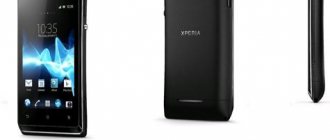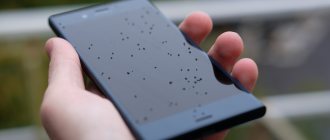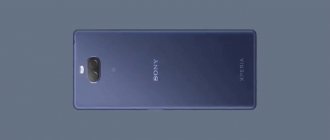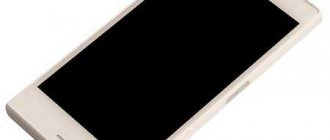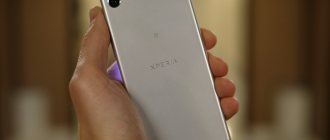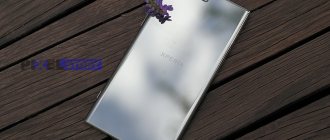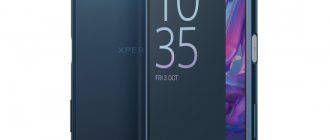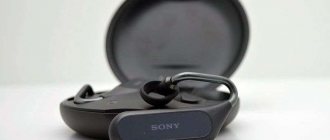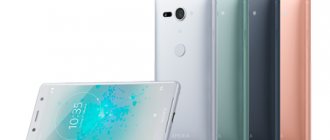Once upon a time, Samsung was ahead of its time by releasing the GALAXY Note, a huge smartphone for its time. It shocked with its gigantic—by those standards—size, but at the same time it was very powerful. Owners of 4-4.5-inch devices called it a “shovel.” However, to be honest, absolutely everyone called it that, even those who managed to purchase it. However, after some time, all more or less powerful smartphones acquired screens of five inches or more, that is, they grew to that same GALAXY Note. And for some reason this did not raise any questions. Yes, mobile phones have grown over the last couple of years, to say the least. And there is nothing wrong with this, except, perhaps, for one thing: they no longer make small devices with powerful technical filling.
Sony at one time assessed that there should still be a demand for such smartphones, and tried to release a smaller copy of its flagship. It turned out well and interesting - the Z1 Compact was like a breath of fresh air and gained a lot of sympathy from both the press and users. However, other companies did not follow Sony’s example and continued to produce simple phones with designs borrowed from flagships as compact devices. So there were no competitors for the devices of the Xperia Z Compact family. Well, the new Xperia Z5 Compact boasts the hardware of the older Z5, and at the same time it fits in the palm of your hand without any problems!
Specifications
| Sony Xperia Z1 Compact | Sony Xperia Z3 Compact | Sony Xperia Z5 Compact | Sony Xperia Z5 | |
| Touch screen | 4.3 inches, 1280 × 720 pixels, pixel density 341.5 per inch; IPS matrix; Capacitive, up to ten simultaneous touches | 4.6 inches, 1280 × 720 pixels, pixel density 319.2 per inch; IPS matrix; Capacitive, up to ten simultaneous touches | 4.6 inches, 1280 × 720 pixels, pixel density 319.2 per inch; IPS matrix; Capacitive, up to ten simultaneous touches | 5.2 inches, 1080 × 1920 pixels, pixel density 423.6 per inch; IPS matrix; Capacitive, up to ten simultaneous touches |
| Air gap | No | No | No | No |
| Oleophobic coating | Eat | Eat | Eat | Eat |
| Polarizing filter | Eat | Eat | Eat | Eat |
| Factory film | No | No | No | No |
| CPU | Qualcomm Snapdragon 800 MSM8974: four Qualcomm Krait-400 cores (ARMv7); frequency 2.15 GHz; 28 nm HPm process technology; 32-bit computing | Qualcomm Snapdragon 801 MSM8974AC: four Qualcomm Krait-400 cores (ARMv7), 2.46 GHz; 28 nm HPm process technology; 32-bit computing | Qualcomm Snapdragon 810 MSM8994: four cores ARM Cortex-A57 (ARMv8), frequency 2 GHz + four cores ARM Cortex-A53 (ARMv8), frequency 1.5 GHz; process technology 20 nm HPm; 32- and 64-bit computing | Qualcomm Snapdragon 810 MSM8994: four cores ARM Cortex-A57 (ARMv8), frequency 2 GHz + four cores ARM Cortex-A53 (ARMv8), frequency 1.5 GHz; process technology 20 nm HPm; 32- and 64-bit computing |
| Graphics controller | Qualcomm Adreno 330, 450 MHz | Qualcomm Adreno 330, 578 MHz | Qualcomm Adreno 430, 650 MHz | Qualcomm Adreno 430, 650 MHz |
| RAM | 2 GB LPDDR3-1600 | 2 GB LPDDR3-1600 | 2 GB LPDDR3-1600 | 3 GB LPDDR3-1600 |
| Flash memory | 16 GB (about 11.5 GB available to the user) + microSD | 16 GB (about 11.5 GB available to the user) + microSD | 32 GB (about 20.5 GB available to the user) + microSD | 32 GB (about 20 GB available to the user) + microSD |
| Connectors | 1 × Micro-USB 2.0 (MHL) 1 × 3.5 mm headset jack 1 × microSD 1 × Micro-SIM | 1 × Micro-USB 2.0 (MHL) 1 × 3.5 mm headset jack 1 × microSD 1 × Nano-SIM | 1 × Micro-USB 2.0 (MHL) 1 × 3.5 mm headset jack 1 × microSD 1 × Nano-SIM | 1 × Micro-USB 2.0 (MHL) 1 × 3.5 mm headset jack 1 × microSD 1 × Nano-SIM |
| cellular | 2G/3G/4G One SIM card in micro-SIM format | 2G/3G/4G One nano-SIM format SIM card | 2G/3G/4G One nano-SIM format SIM card | 2G/3G/4G One nano-SIM format SIM card |
| Cellular connection 2G | GSM/GPRS/EDGE 850/900/1800/1900 MHz | GSM/GPRS/EDGE 850/900/1800/1900 MHz | GSM/GPRS/EDGE 850/900/1800/1900 MHz | GSM/GPRS/EDGE 850/900/1800/1900 MHz |
| Cellular 3G | DC-HSPA+ 850/900/1700/1900/2100 MHz | DC-HSPA+ 850/900/1700/1900/2100 MHz | DC-HSPA+ 850/900/1700/1900/2100 MHz | DC-HSPA+ 850/900/1700/1900/2100 MHz |
| Cellular 4G | LTE Cat. 4 (150 Mbps) band 1, 2, 3, 4, 5, 7, 8, 20 (2100/1900/1800/1700/850/2600/900/800 MHz) | LTE Cat. 4 (150 Mbps) band 1, 2, 3, 4, 5, 7, 8, 20 (2100/1900/1800/1700/850/2600/900/800 MHz) | LTE Cat. 6 (300 Mbps) band 1, 2, 3, 4, 5, 7, 8, 12, 17, 20, 28, 40 (2100/1900/1800/1700/850 /2600 /900/700/800/ 2300 MHz) | LTE Cat. 6 (300 Mbps) band 1, 2, 3, 4, 5, 7, 8, 12, 17, 20, 28, 40 (2100/1900/1800/1700/850 /2600/ 900/700/800/ 2300 MHz) |
| WiFi | 802.11a/b/g/n/ac, 2.4 and 5 GHz + Wi-Fi Direct | 802.11a/b/g/n/ac, 2.4 and 5 GHz + Wi-Fi Direct | 802.11a/b/g/n/ac, 2.4 and 5 GHz + Wi-Fi Direct | 802.11a/b/g/n/ac, 2.4 and 5 GHz + Wi-Fi Direct |
| Bluetooth | 4.0 | 4.0 | 4.1 | 4.1 |
| NFC | Eat | Eat | Eat | Eat |
| IR port | No | No | No | No |
| Navigation | GPS, A-GPS, GLONASS | GPS, A-GPS, GLONASS, BeiDou | GPS, A-GPS, GLONASS, BeiDou | GPS, A-GPS, GLONASS, BeiDou |
| Sensors | Light sensor, proximity sensor, accelerometer/gyroscope, magnetometer (digital compass) | Light Sensor, Proximity Sensor, Accelerometer/Gyroscope/Pedometer, Magnetometer (Digital Compass), Barometer | Light Sensor, Proximity Sensor, Accelerometer/Gyroscope/Pedometer, Magnetometer (Digital Compass), Barometer | Light sensor, proximity sensor, accelerometer/gyroscope/pedometer, magnetometer (digital compass), barometer |
| Fingerprint's scanner | No | No | Eat | Eat |
| Main camera | 20.7 MP (5248 × 3936), Sony Exmor RS matrix with back-illumination, 1/2.3 inches Autofocus, LED flash | 20.7 MP (5248 × 3936), Sony Exmor RS matrix with back-illumination, 1/2.3 inches Autofocus, LED flash | 23 MP (5520 × 4140), Sony Exmor RS matrix with back illumination, 1/2.3 inches; Hybrid autofocus, LED flash | 23 MP (5520 × 4140), Sony Exmor RS matrix with back illumination, 1/2.3 inches; Hybrid autofocus, LED flash |
| Front-camera | 2.1 MP (1920 × 1080), Sony Exmor R back-illuminated sensor | 2.1 MP (1920 × 1080), Sony Exmor R back-illuminated sensor | 5.1 MP (2592 × 1944), Sony Exmor R back-illuminated sensor | 5.1 MP (2592 × 1944), Sony Exmor R back-illuminated sensor |
| Nutrition | Non-removable battery: 8.7 Wh (2300 mAh, 3.8 V) | Non-removable battery: 9.88 Wh (2600 mAh, 3.8 V) | Non-removable battery: 10.26 Wh (2700 mAh, 3.8 V) | Non-removable battery: 11.02 Wh (2900 mAh, 3.8 V) |
| Size | 127 x 65 mm Case thickness: 9.5 mm | 127 x 65 mm Case thickness 8.6 mm | 127 x 65 mm Case thickness 8.9 mm | 146 x 72 mm Case thickness 7.3 mm |
| Weight | 135 g | 129 g | 138 g | 154 g |
| Housing protection | IP55, IP58 Up to half an hour at a depth of 1 m | IP65, IP68 Up to half an hour at a depth of 1.5 m | IP65, IP68 Up to half an hour at a depth of 1.5 m | IP65, IP68 Up to half an hour at a depth of 1.5 m |
| operating system | Android 4.4 KitKat Sony Xperia's own shell | Android 4.4 KitKat Sony Xperia's own shell | Android 5.1.1 Lollipop Sony Xperia's own shell | Android 5.1.1 Lollipop Sony Xperia's own shell |
| Average retail price | About 18 thousand rubles | About 25 thousand rubles | About 40 thousand rubles | About 50 thousand rubles |
| Sony Xperia Z5 Compact – information about the system and hardware according to the CPU-Z application | ||
⇡#Appearance and ergonomics
As we know from the Xperia Z5 review, Sony decided to return to strict shapes, straight lines and corners with a small radius of curvature. For our taste, they did the right thing: the design returned some of the originality that was missing in the Z3. The Xperia Z5 Compact is a small rectangular brick. By the way, the gadget turned out to be quite plump: its case thickness is 8.9 millimeters, and you involuntarily pay attention to this. I would like the body to be a little thinner - a “compact”, in our subjective opinion, should be compact in everything. But the battery is more important, and everything cannot happen at once. The device does not weigh that much – 138 grams. It’s convenient to use – your hand (and you almost never need two hands here) doesn’t get tired even after long periods of work.
Sony Xperia Z5 Compact – front panel
Straight side edges and barely rounded corners, surprisingly, do not dig into the palm, but the thumb is what compact phones are for! — reaches any point on the display without any difficulty. Operating the Z5 Compact with one hand is so convenient that it’s even somewhat unusual. For example, 5-inch devices, which, in principle, can also be used with one hand, require moving in the palm of your hand, but this one does not.
Sony Xperia Z5 Compact – front panel
The Xperia Z5 Compact comes in four colors: traditional black and white, as well as yellow and coral pink. The last option ended up in our test laboratory.
Sony Xperia Z5 Compact – color options (official photo)
There are no hardware buttons on the front panel - the operating system navigation keys are located on the display. At the top of the front panel there is an LED indicator of new events, a front 5-megapixel camera lens and a speaker slot, and at the bottom there is a slot for the main speaker.
Sony Xperia Z5 Compact with screen on
The layout of the controls on the Z5 Compact is completely standard for a Sony smartphone - those who have used any of them at least once won’t even need to get used to it. The power key, volume control and camera activation buttons are located on the right side.
Sony Xperia Z5 Compact – hardware keys
The power key on the device is the same elongated one as in the Xperia Z5. We had to give up the beautiful round button in order to have somewhere to put the fingerprint scanner. With its help, you can not only unlock your device, but also pay for purchases in online stores. The fingerprint sensor works quite correctly and accurately: the percentage of response errors during testing was even less than that of the original Z5, which is strange - the sensors are the same. The point, most likely, is that the sensor is located on the side of both smartphones, but placing your finger on the compact body of the younger model is simply a little more convenient. In total, up to five fingerprints can be stored in the device’s memory - in case more than one person uses the gadget.
| Sony Xperia Z5 Compact – setting up the fingerprint scanner | ||
The layout of the interfaces is standard: a 3.5 mm audio jack is located at the top end, a micro-USB connector with video output (MHL) is hidden on the bottom edge.
| Sony Xperia Z5 Compact – side ends | ||
Nano-SIM and microSD cards are installed in slots on the left side, hidden under a massive plastic plug. To maintain dust and water resistance, it must be pressed tightly against the body. If this condition is met, the Xperia Z5 Compact can be in fresh water at a depth of up to one and a half meters for half an hour. True, if earlier Sony actively emphasized this, now they modestly hush it up - the phone, of course, is protected according to IP65 and IP68 standards, but failure due to water ingress is not recognized as a warranty case. So you can bathe the device, but only at your own peril and risk.
Next to the plug there is a fastening for a neck strap - a rare attribute these days.
Sony Xperia Z5 Compact – card slots
The back panel of the smartphone is covered with matte protective glass. It is not only completely resistant to scratches and other minor damage, but also practically does not stain! It is not so easy to leave a greasy fingerprint on it - and this is definitely good: the gadget retains its pristine beauty for a long time. Another plus is that the surface of the back panel is very pleasant to the touch, and the device does not slip in your hands.
Sony Xperia Z5 Compact - rear panel
The body of the device, like other Sony smartphones, is non-separable. On the back panel there is a main 23-megapixel camera lens and an LED flash. The gadget is assembled well - we did not find any creaks or play, and we don’t have to complain about the lack of rigidity. The design of the Xperia Z5 Compact is much less sleek and much more distinctive than the previous Z3 Compact. We approve. Even in pink.
Appearance and ease of use
Recently, Sony has hardly changed the appearance of its flagships. An uninitiated user will not be able to distinguish the Z5 Compact from the Z3 Compact or Z1 Compact; the general style of the smartphones remains the same, and the dimensions have changed minimally.
We received a coral-colored device for review, which will appeal to the fair sex, but there are other colors - white, black and yellow.
The main external difference between the Z5 Compact and the Z3 Compact is the frame. Now it looks wider, resembles a piece of colored rubber, and makes the device feel cheap. Previous Compact smartphones look much more expensive.
The display is slightly recessed into the body, which theoretically should protect it from scratches. Above the screen there is a front camera, an earpiece, a Sony logo, proximity and light sensors, and a missed events LED.
The layout of the controls is typical for Sony. All mechanical keys are on the right side. The power key combined with the fingerprint scanner is in the center of the edge. Significantly below it is a tiny volume rocker. Even lower is the camera key.
On the right side, under a flap, there is a tray for a nanoSIM format SIM card and a microSD memory card. At the top end there is a 3.5 mm audio jack and an additional microphone. On the bottom there is a microUSB port and the main microphone.
The back side of the smartphone is covered with frosted glass, which is recessed deep into the body relative to the frame. In its upper left corner there is a 23 megapixel camera lens and a single LED flash.
With smartphone ergonomics, everything is not so smooth. Using the volume key during a call is inconvenient. It is too low, and if you hold the smartphone with your right hand, it is difficult to press it with your thumb. On the other hand, a clear advantage remains the small screen diagonal, thanks to which those with small hands can comfortably use the smartphone.
I also liked the location of the power key and the operation of the fingerprint scanner. The unlocking process is the same as in Samsung smartphones - you need to press a key and the smartphone turns on. This happens quickly and in most cases the first time.
Otherwise, there are no critical complaints about the ease of use. Protection against water and dust (IP65 and IP68) has not gone away. In other words, the Z5 Compact can get caught in the rain or fall briefly into water and it won't kill it.
⇡#Display
The characteristics of the Z5 Compact screen have not changed since the Z3 Compact - the smartphone has a 4.6-inch display with a resolution of 1280 × 720 pixels. It has a pixel density of 319.2 ppi. Of course, such a low resolution by modern standards in a smartphone for 40 thousand rubles is puzzling. This is, at a minimum, frivolous, and at a maximum, a little dishonest towards users. However, you can try to attribute the HD resolution to the fact that Sony tried to maintain a balance and not stuff the Z5 Compact with too much stuff. After all, if you think about it, a value of 319 PPI is quite enough for comfortable work. We didn’t come up with this, it’s kind of a well-known fact.
Only a picky user will see individual dots on the Z5 Compact display, and he will have to peer at the surface of the screen for quite a long time; the “pixelation” effect is almost completely absent. All fonts, even the smallest ones, look sharp - reading electronic documents from the Z5 Compact screen is comfortable. In general, I don’t want to complain about the small resolution during operation; in the case of the Z5 Compact, it is not annoying. On the other hand, if you put some gadget with a Quad HD screen next to it, it will become obvious that higher resolution displays were not developed out of nothing to do - they have a clearer picture.
| Sony Xperia Z5 Compact – display settings | ||||
The display is made using IPS technology. Its viewing angles are average: when you move your gaze significantly away from the perpendicular, the black color begins to lose depth. This shortcoming does not interfere with working with the device, but it is difficult not to pay attention to it – the drop in contrast is quite noticeable. The gadget is responsive and responds to touch quickly and accurately. The device supports the standard ten simultaneous presses and easily recognizes gestures. In the corresponding settings item, you can increase the sensitivity of the touch layer so that the device understands touches with loose gloves - this is very important now.
Sony Xperia Z5 Compact – AnTuTu MultiTouch Test results
The front panel of the smartphone is covered with tempered glass, resistant to damage. Sony, as usual, does not specify its manufacturer. There is no air gap between it and the matrix, due to which some of the reflections in the surface of the screen are eliminated. The glass here has a grease-repellent coating, pleasant to the touch. It doesn’t get dirty as quickly as it could, and you can get rid of the “fingers” using any cloth at hand. Finally, the Z5 Compact has a polarizing filter that reduces glare on the screen in bright light. In general, the display is made to last.
In addition, it is very bright. Its white field luminosity ranges from 16 cd/m2 to a mind-blowing 638 cd/m2. The smartphone is convenient to use in absolutely any conditions – both in pitch darkness and in bright sunshine. It does not harm the eyes at night, and does not fade in direct sunlight. The gadget can independently adjust the brightness level that is comfortable for working in different conditions, so there is no need to adjust the backlight slider once again - it copes with this task quite well on its own. Brightness adjustment is smooth, in accordance with the lighting.
What's really nice is that the Z5 Compact's display is significantly more contrasty than the Z3 Compact's. The contrast ratio has increased from a weak 685:1 to a much more acceptable 1029:1. True, the black luminosity at maximum brightness of the Z5 Compact display is still quite high - 0.62 cd/m2. Because of this, the black color may lose some saturation. However, with such a reserve of brightness this is quite expected and, moreover, excusable.
According to the old and not very good tradition, Sony customizes its displays in its own strange way. In the Z5 Compact, as in other Sony devices, the screen is frankly cold. The color temperature of shades of gray is significantly higher than the reference value of 6500 K - on average it is 8500 K. If desired, the user can adjust the white balance using a special utility. The device also has two software “enhancers” that correct color reproduction depending on the type of content being displayed: X-Reality for Mobile and “Ultimate Brightness Mode.” We tested the display with software filters disabled.
| Sony Xperia Z5 Compact – gamma curves of grayscale (left) and color components (right) in comparison with the reference curve (indicated by a dotted line on the graphs) | ||
All gamma curves almost coincide with the reference curve, and you can safely close your eyes to minor deviations. Perhaps its only significant drawback is its frankly “cold” colors. Low resolution is a matter of taste and personal needs; this was enough for us.
Sony Xperia Z5 Compact review
9
Rating: 4.24 (7 votes)
The Xperia Z5 Compact stands alone: Sony is the only manufacturer offering an Android version of the small, high-end smartphone right now. This means that Compact's stand this year is very limited. It's probably the only one on the market that offers high specs in a smaller form factor this year.
Like the Sony Xperia Z3 Compact before it, the Xperia Z5 Compact offers an impressive range of features, fits comfortably in the palm of your hand and makes you wonder why other manufacturers aren't interested in this niche.
Not everyone wants a giant smartphone, and who can blame users for wanting to use the entire screen area without having to use a second hand?
The Xperia Z5 Compact sits next to two other new Sony flagships. This is the Sony Xperia Z5, which offers a 5.2-inch diagonal with a Full HD 1080p panel and 3 GB of RAM. There is also the Xperia Z5 Premium, which will hit the market in November with a 5.5-inch screen and 4K resolution.
One of the main problems with the Xperia Z5 Compact remains its price. Powerful hardware requires powerful prices, even if the smaller form factor forces users to expect discounts. However, the new smartphone comes noticeably cheaper than the Xperia Z5, maybe even cheaper than you expected.
The new Xperia Z5 Compact costs about 43,000 rubles abroad - this is 10,000 cheaper than the price tag that Sony initially set on its website. The new price matches the price of the Xperia Z3 Compact when it launched last year, but you get much more with the new smartphone. Sony Xperia Z5 Compact review more...
Design Sony Xperia Z5 Compact
The Xperia Z5 Compact continues the attractive design established by the Xperia Z5. And if the size of the smaller smartphone doesn't make a significant difference - the Compact measures 127 x 65 x 8.9mm versus the Xperia Z5's 146 x 72 x 7.3mm - it's enough to make you feel the difference.
The Sony Xperia Z5 Compact has thin screen sides, which were a bit too much on the original Xperia Z5, so the screen may appear larger.
You may have noticed that the Z5 Compact is actually larger than the Z5 in one way: it's a little thicker. This is an obvious solution that provides high-quality performance and a large battery. You'll hardly notice the difference in thickness in everyday use since it requires placing two smartphones side by side, but even then you won't notice a shocking difference.
The Sony Xperia Z5 Compact smartphone weighs 138 grams, that is, it is 16 grams lighter than the Z5. Design wise it offers the size and weight of the iPhone 6S.
The rear panel has become much nicer with the new Compact version. Instead of the clear glass on the back like previous Sony smartphones, you get a frosted glass that feels great in the palm and looks stylish.
Color options: white, black, yellow or coral - I had the opportunity to use all smartphones for this review except the white one. I also note that the black smartphone looks the most stylish, while the yellow and coral ones are very bright. Bright colors aren't my thing, but for users who want a standout iPhone aesthetic, this is a great solution.
Corners have been rounded off the new Z5 Compact more than on the Z3 Compact, making it much more comfortable in the hands.
Protective corners of the Xperia Z5 were not included in the Compact's design, so the smaller smartphone is much more likely to be damaged if it falls on one of the four corners. It is unclear why Sony made this decision - it seems to us that it is not difficult to implement protection, because these corners are important for the durability of the smartphone.
At the top left edge of the smartphone you'll find an embossed Xperia logo, which looks much better this year. At the bottom of the same edge of the smartphone there is a single flap covering the MicroSD and NanoSIM slot.
The flap is easier to open than on previous Xperia smartphones, and you only need to do this in those rare cases when you change the SIM card or MicroSD.
At the center of the bottom edge of the smartphone you will find a Micro USB port for charging and data transfer. It's disappointing that Sony doesn't use USB Type-C to minimize connection time, but at least there's no more flap.
On the other hand, there is no reason to rush for a new USB standard, even if it will help the manufacturer stand out in the market. In a few years, all smartphones will switch to USB Type-C, which will become the norm, but today most users use the original Micro USB.
The headphone jack is located at the top of the smartphone on the left side, which is the best place for it since you can carry the smartphone in your pocket when using a wired headset.
At the bottom right edge of the smartphone there is a camera shutter button, an ideal position for a button in landscape mode. Just above you will find the volume button, which comes from the Xperia Z3 Compact. This position is not as successful because users will have to get used to the layout.
It would have been better to place the volume controls just above the power button on the same side, but at least it's not as bad as on the Xperia Z5. On a large smartphone, the button is really difficult to press, moreover, you almost completely lose contact with the phone if you hold it with one hand.
The power button is flush with the smartphone body. This is a metal button with On/Off engraving. The button looks good, but the most exciting part is that hidden inside is a fingerprint scanner - a new addition to the Xperia Z series.
On the front of the smartphone, you will find a screen bezel at the top and bottom to accommodate the front-facing speaker, microphone, and front-facing camera. The bezels are thinner on the Xperia Z5 Compact than on the Xperia Z5, meaning you get a better screen-to-body ratio.
Sony Xperia Z5 Compact display
The new Sony smartphone offers a 4.6-inch screen with a resolution of 1280 x 720 pixels. The diagonal resolution offers us a density of 323 pixels per inch, which is not the 428 pixels per inch of the Xperia Z5 or the huge 806 pixels per inch of the Xperia Z5 Premium.
Full HD (1080p) is the standard in the mobile market today, and some smartphones offer 2K and even 4K displays, so Sony should be ashamed of itself for taking such a conservative approach to the display with the new Compact.
Of the major manufacturers and recent releases, only the Moto G is stuck with an HD panel (720p), but it costs only a third of the Xperia Z5 Compact's price tag.
The Sony Xperia Z5 Compact, which challenges premium smartphones in 2020, does not offer a Full HD screen, a risky move. However, the screen isn't terrible at all - the image is beautiful and you won't find any shortage of pixels most of the time.
On the other hand, not being able to watch most YouTube videos in their native resolution is disappointing, especially if you've spent so much money. And although this is not a disaster, I personally would think twice before recommending such a smartphone to buyers.
Sony's proprietary screen technology ensures this is a bright panel, but there will be times when you can see individual pixels, which won't happen with the Xperia Z5.
The viewing angles of the screen have improved significantly, you can look at the smartphone screen at sharp angles and the picture will remain much clearer than on the Xperia Z3 Compact. Checked in review.
The screen also offers the optimal size for a smartphone. Many users are happy with 4.6-inch screens, so it's worth recognizing that Sony's solution is not without elegance and efficiency.
Key features of Xperia Z5 Compact
A fingerprint scanner comes to the Xperia series for the first time. On the Xperia Z5 Compact it is located on the right side, inside the power button, which is flush with the smartphone body.
Sony is up to speed on security ahead of the release of Android Pay, so it's no surprise that flagship smartphones are getting biometric protection.
Considering this is the company's first attempt at implementing a fingerprint scanner, it works surprisingly well. During my review of the Sony Xperia Z5 Compact, I registered five fingerprints and did not experience any problems unlocking the smartphone.
However, I didn't register all the fingers at first. As a result, several times I locked my smartphone after accidentally placing the wrong finger on the button.
The position of the scanner also complicates the situation when you are trying to unlock a smartphone lying on the table. But otherwise, the scanner works at lightning speed, without any lengthy loading times or animations, allowing you to access the device in record time, making the scanner more efficient than a PIN code.
Sony phones also have a traditional advantage - they are durable. The Sony Xperia Z5 Compact is water and dust resistant, so you can simply rinse your smartphone under the tap when it gets dirty.
Therefore, there is no reason to worry about rain, your smartphone falling into the sink, or even a foam party at the club. You can also take your smartphone to the beach and not worry about sand getting stuck in the cracks of the case.
And this time, features don't come at the expense of design. Sony Xperia Z5 Compact is limited to only one plug, the rest of the ports are water resistant.
The Sony Xperia Z5 Compact also supports PS4 Remote Play, meaning PlayStation 4 owners can play games on their smartphone while they're on the same Wi-Fi network. Eventually, this feature will be extended to 4G, allowing you to play your PS4 games even while traveling or on vacation.
The problem becomes the screen size. With a 10.1-inch screen and 2K resolution, the Sony Xperia Z4 Tablet offers PS4 Remote Play at its best. Trying to play Rocket League on a 4.6-inch 720p screen will end in failure. During the review, I connected a controller so as not to block the screen with my fingers for virtual control, but even so it was difficult to control the action happening on the screen.
I also tried The Witcher 3: Wild Hunt on the Xperia Z5 Compact, which was even worse. As soon as the battle began, I stopped seeing what I was doing, so I had to abandon this idea.
Performance Sony Xperia Z5 Compact
The Sony Xperia Z3 Compact showed some impressive results in the performance department, but the Xperia Z3 Plus tarnished the series name with terrible overheating under load.
Surprisingly, Sony is once again using the same processor found on the Xperia Z3 Plus (Qualcomm Snapdragon 810 with 3GB RAM) inside the Xperia Z5 Compact.
Therefore, my expectations were biased. I opened the review of the smartphone with trepidation, fearing that it would get hot on the simplest tasks - but a surprise awaited me. I didn't experience any issues with the Xperia Z5 Compact, nor did it get as hot as the Xperia Z5.
Moving from application to application revealed some problems. The camera app takes time to load, and navigating to the Gallery app from the Camera app also takes time.
Despite this, I didn't experience any performance issues with the Xperia Z5 Compact during the rest of the review, and overall I was impressed, especially after the Xperia Z3 Plus.
During gaming, the smartphone performed quite well, offering fast loading and no heat after an hour of gaming.
And while the older Xperia Z3 Plus gets noticeably warm already in the browser, the Xperia Z5 Compact remains cold even after half an hour of use.
Next, as required by the review, the smartphone went to tests in GeekBench 3, where it scored an average of 1374 points in the single-core test and 3881 points in the multi-core test. Compared to the Xperia Z3 Compact's scores - the score is staggering - the previous Compact scored 949 points on the single-core test and 2,760 points on the multi-core test.
An impressive upgrade considering the Z3 Compact only launched a year ago. However, it's difficult to rank the Z5 Compact against the competition since the premium compact smartphone niche is essentially empty. The Sony Xperia Z5 remains slightly faster, offering 1312 points and 4015 points on the same tests.
Battery Sony Xperia Z5 Compact
And while Sony has reduced the battery size on the Xperia Z5, the new Sony Xperia Z5 Compact has increased the battery from 2600 mAh on the Z3 Compact to 2700 mAh on the Z5 Compact. The older Z3 Compact offered impressive battery life and the new smartphone will not disappoint.
I'm a heavy user - watching videos, texting over 4G and streaming music - but I've repeatedly ended the day with some juice left on the battery. Most of this year's flagship smartphones ran out of juice in my hands by the end of the day (including the Xperia Z5), so the result is impressive.
Of course, you can’t count on two days of charging. With less active use, the smartphone lasted until lunch the next day.
In video tests (where we run a 90-minute video with active 4G and Wi-Fi, as well as full screen brightness), the smartphone dropped to 79% charge. And this is the same figure as the Xperia Z3 Compact. An unexpected result because I expected more.
But let's compare the results with this year's leading flagships and you'll see just how good the Xperia Z5 Compact's battery is. For example, the original Xperia Z5 only retained 75% of its battery charge after 90 minutes, even though we're talking about a 5.2-inch Full HD panel. Let's repeat the video playback with the screen at 50% brightness, and the Xperia Z5 Compact will retain 84% of the battery charge. Under these conditions, the Xperia Z5 is much closer, 82% of charge on the same test.
When it comes to gaming, the Sony Xperia Z5 Compact smartphone offers impressive endurance. After an hour of gaming with the screen set to full brightness and active connections, the smartphone retained 72% battery charge.
The result is much better than on the Xperia Z5, which somehow managed to use 41% of its battery while playing games. However, Sony smartphones cannot compete with the Samsung Galaxy S6's offering, which can provide more than five hours of playback.
Sony doesn't offer wireless charging features on the Xperia Z5 range, nor does it skip USB Type C, which isn't a significant issue, although we can again see the absence of the future standard on Sony flagships.
With Qi wireless charging technology offered by many of this year's flagships, and IKEA even offering desks that include built-in chargers, the adoption of wireless charging technology seems inevitable.
Cameras Sony Xperia Z5 Compact
Despite its popular sensors, Sony hasn't competed with the leading mobile cameras, however, this time Sony is upgrading the cameras across the entire Xperia Z range. The 23-megapixel sensor of the Xperia Z5 Compact offers the highest pixel count on the market, next to the Moto X Style. The Xperia Z5 Compact also gets new auto focus and zoom, along with other features we've seen on previous Xperia cameras.
And Sony's efforts have paid off, although the Xperia Z5 Compact offers photography improvements but won't be the market leader in smartphone photography: in testing, some low-light photos certainly came out better on other smartphones.
If you experience any issues with your camera, you can make adjustments manually, which should improve the quality of your final photos.
Auto focus on the Xperia Z5 Compact becomes a key feature of the camera. According to Sony, the reaction time is 0.03 seconds, which means you can catch almost any shot, even if your hands are shaking.
And it works great with stationary objects: Quickly take your smartphone out of your pocket, load the camera app and the shot is essentially ready.
This is a great development from a technology standpoint, but the solution doesn't work so well when the object is moving. I tried to take a photo on the subway. Approximately, the train was moving at 15 km/h, but the Xperia Z5 Compact didn't have the shutter speed I was hoping for.
The camera app isn't fast enough. Transitions between functions take a while to load, which isn't a good result when getting the settings right for a good shot only leaves you with a split second.
Navigating to the gallery using the shortcut on the right side of the interface also remains slow. I would like to see it load faster so I can look at the last photo I took, make sure everything is ok, and move on.
On the front of the smartphone, you'll find a 5.1-megapixel selfie camera that promises impressive shots - a significant upgrade from last year's Z3 Compact's 2.1-megapixel sensor.
The front camera is similar to what the rest of the market offers - it's not great, but there aren't any major complaints. I also noted that the front camera captures a lot more light than the rear camera, as usual in the Xperia series.
Summing up
Earlier this year, rumors surfaced that Sony was considering ditching smartphones altogether, so the Xperia Z5 is bound to be a success. And the new line of smartphones becomes a well-deserved final touch, with the Xperia Z5 Compact becoming the crown jewel of the series.
Many users will be distracted by the standard Xperia Z5 and the shiny Xperia Z5 Premium with its 4K display, but in terms of its combination of design, performance and functionality, the Compact is without a doubt a standout.
We liked…
If you're looking for a powerful battery without compromising on design, this is your choice. The new Xperia Z5 Compact offers a better battery than most competitors, and the benchmark results are very good.
The fingerprint scanner can be seen as a simple and obvious upgrade; such a high-quality result is impressive the first time. The Galaxy S6 offers an amazing fingerprint scanner, but its iteration on the Galaxy S5 was terrible.
The positioning of the scanner is perfect, it responds incredibly quickly and will make contactless payments very convenient when Android Pay launches on smartphones.
The design deserves special mention. Considering that this is a smaller smartphone, Sony has packed key features into it. It's a little thicker than the Xperia Z5, but you'll only notice the difference if you put the smartphones side by side; the Compact also feels more comfortable in the hand.
The lack of caps is a nice bonus; Sony has achieved this without compromising the waterproof properties of the smartphone, which has always been an important selling point of the Xperia series smartphones.
On top of that, Sony has provided the device with an eye to the future, supporting MicroSD up to 200 GB. And while 200 GB Micro SD cards are not available everywhere, their popularity is sure to grow in the future.
We didn't like it...
Screen resolution is taking a step back. The HD panel just doesn't match what we expected from a 2020 smartphone, I would have liked to see a Full HD panel.
If the Compact had a Full HD panel, we would have given it 10 stars in the review - but I understand why the manufacturer held back 720p. Savings on pixels are reflected in better battery life; many users prefer long-lasting smartphones to the added clarity of YouTube videos.
The fact that Sony didn't increase the price tag for this year's model is also good, although the Z5 Compact remains an expensive smartphone. If Sony could offer the Xperia Z5 Compact to the Russian market with a price tag of up to 35,000 rubles, we would find no reason not to recommend the smartphone to everyone.
I understand that this is not the first time when it comes to Sony smartphones, but I would like to see pure Android. The Xperia UI just isn't pretty, so we'd be happy not to see it on Sony's next smartphones.
And while most major competitors offer fast charging and wireless charging technology, Sony has abandoned them. This is not enough to stop buying a smartphone, but it is, without a doubt, an omission.
Final verdict
If you're looking for a small Android smartphone right now, this is it. No other smartphone manufacturer offers such a high-end device in a small form factor, which is strange since the Xperia Z5 Compact, like all smartphones in this series, has been proving its versatility for years.
With excellent battery life, a new high-end processor and some impressive camera upgrades, it's worth an upgrade even if you're a user of last year's Xperia Z3 Compact. The screen remains the same, which is unfortunate, but it affects the battery. The smartphone has a lot of positive aspects, while there are only a few criticisms.
All we can hope for is that Sony will believe in the new smartphone, and we won’t see a weak alternative in the form of the Xperia Z6 Compact in March.
Sony Xperia Z5 Compact review
Olarien
26.10.2015
9/10
Sony's new little smartphone is the crown jewel of the Xperia Z5 range - the only drawback is that the manufacturer forgot to include Full HD.
9 Summary of the review
Verdict: Sony's new little smartphone is the crown jewel of the Xperia Z5 range - the only drawback is that the manufacturer forgot to include Full HD.
Rating: 4.24 (7 votes)
⇡#Hardware and performance
Now let’s try to explain why we didn’t get attached to the low resolution and blame Sony for all the mortal sins for it. The fact is that the Z5 Compact has a Qualcomm Snapdragon 810 installed. This platform is still one of the most powerful system-on-a-chip at the time of publication of this material. It easily “pumps up” Full HD and even Quad HD displays, and for a modest HD screen it draws the picture not just quickly, but instantly. It makes the Z5 Compact feel phenomenally smooth. Watching this gadget “crack” benchmarks one after another like nuts is a real pleasure.
A combination of four ARM Cortex-A53 cores operating at 1.5 GHz and four ARM Cortex-A57 cores operating at 2 GHz, complemented by a powerful Qualcomm Adreno 430 graphics controller, allows the device to solve any tasks that a smartphone can offer. The power reserve here is clearly enough for the next one and a half to two years, or even more. The platform uses the current ARMv8 instruction set and supports both 32-bit and 64-bit computing.
There is not very much RAM in the device - only two gigabytes. Again, some dissonance arises: on the one hand, for a device costing forty thousand rubles this seems to be not enough; for decency, at least 3 GB of RAM should be installed; on the other hand, this volume of the Z5 Compact is quite enough, again thanks to the HD screen. The gadget doesn’t hesitate when switching between applications and can keep many open browser tabs in memory. The built-in flash memory in the device is 32 GB, but of this a little more than twenty gigabytes are available to the user, the rest of the space is reserved by the system. If necessary, you can install a microSD memory card in the Z5 Compact.
In general synthetic tests - AnTuTu Benchmark 5 and Geekbench 3 - the device shows results that are completely standard for the Snapdragon 810. The compact's ratings are the same as those of the older Xperia Z5. For example, in the AnTuTu task both devices scored more than 53 thousand points, the difference in scores is minimal. This is not at all surprising, because both smartphones are built on the same platform.
The superiority of the Xperia Z5 Compact becomes obvious and undeniable as soon as you run gaming tests on it. In them, it was 20-30% faster than the flagship Z5 - this is due to the low resolution screen. It's very pleasant to play on the compact; it handles the heaviest applications without any problems.
Design and equipment
There are 4 main colors for this smartphone: white, black, coral, yellow. The smartphone itself is completely made in the OmniBalance style, characteristic of Sony devices. Despite all the rumors that have been circulating for quite some time that the company is about to abandon this concept, this has not happened yet, except for the lack of side frames in the Sony Xperia Z5 model.
In the Compact model, the back panel has the effect of fogged glass and, it should be noted, looks very good, being a good alternative to the already boring glossy panel. It is almost impossible to leave fingerprints here; scratches appear on it extremely rarely, and if they do appear, it is quite difficult to notice them. In a word, a very good solution that made the smartphone more convenient and of better quality.
As for the mechanical key, it has a very good response, and it also reads fingerprints very accurately and quickly. I must say, this was noticed and appreciated by many owners of the Sony Xperia Z5 Compact model - their reviews left on various sites speak about this. In addition to a good processor and high performance, reviews often mention a convenient and fast mechanical key.
The smartphone also has a proximity and light sensor, which is located above the screen. In addition to this sensor, the front camera, speaker and LED indicator are also located above the screen. It should be noted: the smartphone has very good sound, which has a stereo effect. Moreover, it is a real stereo, since two speakers of the device play multimedia simultaneously, while the volume is at a very high level, even despite the waterproof membranes installed on the speakers.
Therefore, if you like to play games on your smartphone or watch movies, you can fully immerse yourself in their atmosphere due to the powerful sound that this smartphone can offer. However, there is a small problem: probably not everyone will want to do this at full volume without headphones. The fact is that when the sound is set to full power, the back panel of the device begins to vibrate quite strongly, which is very noticeable with your fingers.
On the left side of the device there is a hook for a lanyard, as well as slots for a memory card and a SIM card. On the right side you can find the power key, as well as a mechanism for adjusting the volume and a camera button. It should be noted that adjusting the volume is sometimes not very convenient, especially if the device is in the left hand. At the bottom there is a microphone and a microUSB connector, and at the top there is an additional microphone and an audio jack.
The box along with the smartphone contains documentation, charging, and a microUSB cable. It should be noted that this is already a very familiar policy for Sony, which does not like to add various additional devices and so on to the kit. According to the company, the consumer himself is able to purchase everything he needs, which is why they limit themselves to such a modest package, which can be traced in almost all Sony models. Thus, if you want to use this smartphone as conveniently as possible, then, for example, you will have to buy headphones or a case for the Sony Xperia Z5 Compact yourself. However, this will most likely not be a big problem, since additional accessories are inexpensive these days.
⇡#Communication and wireless interfaces
We can’t tell you anything particularly interesting about the Z5 Compact’s wireless interfaces – everything here is quite simple and standard. The gadget can work in LTE Cat networks. 6 (maximum theoretical data reception speed – 300 Mbit/s due to aggregation of two bands); All frequencies needed for Russia are supported. You can install only one card in a smartphone; Nano-SIM format SIM cards are used. The device maintains its connection to the network quite reliably and does not lose it for no apparent reason. It is convenient to talk on the Z5 Compact: the speaker has a decent volume reserve, the interlocutors did not complain about poor audibility. The smartphone has an active noise reduction system implemented using two microphones.
| Sony Xperia Z5 – AndroiTS GPS Test results | ||
The set of wireless networks is absolutely standard: Bluetooth, Wi-Fi and NFC. The Z5 Compact, like other modern Xperias, does not have an infrared port. For navigation, a radio module is used that communicates with GPS, GLONASS and BeiDou satellites. It works very quickly - in a matter of seconds after launching the profile test, the gadget detected a total of 25 satellites of three navigation systems and was guided by seventeen of them; the navigation error radius was moderate - ten meters.
⇡#Camera
The set of cameras in the smartphone is exactly the same as in the older Z5: a five-megapixel front camera and a main camera with a new 23-megapixel sensor. We talked about the latter in detail in the review of the flagship model. Let us quote ourselves: “...a 1/2.3” Sony IMX300 sensor with back illumination is used. The increase in the number of pixels is symbolic, but there is a new automatic focusing system. It is hybrid here: contrast and phase focusing methods are used simultaneously. It is stated that the new camera is capable of visiting the subject in 0.03 seconds. It is also said that the five-fold digital zoom on the Xperia Z5/Z5 Compact camera does not affect the quality of photographs. Also, high-aperture optics with a maximum relative aperture of ƒ/2.0 are installed here, and the lens is 24 mm in terms of 35 mm equivalent.”
Sony Xperia Z5 Compact – main camera
Accordingly, we cannot write anything new about the Z5/Z5 Compact camera. The new “compact” shoots better than its predecessor, but there is still room for improvement. Photos with sufficient lighting turn out to be quite bright, rich, detailed and contrasting. However, as shooting conditions worsen, artifacts appear in photographs, contrast drops noticeably, and autofocus sometimes misses the subject. In general, everything is exactly like the Z5 camera.
camtest Sony Xperia Z5 compact
View all images (10)
Specifications
The compact version of the Sony Xperia Z5 runs on the Android 5.1.1 operating system and has a very powerful 8-core processor, 4 cores of which have a frequency of 1.5 GHz, and another 4 have a frequency of 2 GHz, which provides the device with excellent performance. As for memory, 32 GB of permanent memory is installed here, and the RAM capacity is 2 GB. The smartphone also has a microSD slot that can support memory cards up to 200 GB. The screen diagonal is 4.6 inches, the pixel density is 323 ppi, and the resolution is 720x1280. The main camera has a resolution of 23 megapixels and has autofocus, unlike the front camera, which does not have autofocus and has a resolution of 4 megapixels.
The smartphone weighs 138 g, battery capacity is 2700 mAh, the average cost is approximately 40,000 rubles.
As for the technical characteristics, it is impossible not to note the very powerful processor installed on the device. The processor used is the same as in the Sony Xperia Z5. It shows performance records for a number of parameters among all modern smartphones, outperforming many leading models by 20 percent or more. Of course, the presence of such a powerful processor ensures very fast and high-quality operation of the Sony Xperia Z5 Compact: reviews of this device on various sites and blogs only confirm this.
⇡#Autonomous work
The battery in the smartphone is quite acceptable considering the small “underhood space” - 10.26 Wh (2700 mAh, 3.8 V). There is no access to it - the gadget’s body is non-separable. It lasts for a day of battery life under medium loads. During testing, the Z5 Compact did not discharge suddenly, as they say - it always made it home, although it was used as the only means of communication. If you don’t drive the device headlong with the display brightness constantly turned up to maximum, you won’t want to complain about the short battery life.
The device played HD video at maximum brightness with an active Wi-Fi connection for almost seven hours – the result is very decent. If you lower the backlight level a little, you can keep the device in your hands during the entire transatlantic flight.
| Sony Xperia Z5 Compact – energy saving | ||||
All software energy saving algorithms traditional for Sony are also on board the Z5 Compact. The device has STAMINA and Ultra STAMINA modes, which we have already talked about more than once; the gadget can queue data to reduce energy consumption in “sleep” mode. There is also a traditional energy saving mode, which reduces the brightness of the display and disables a number of “gluttonous” options.

